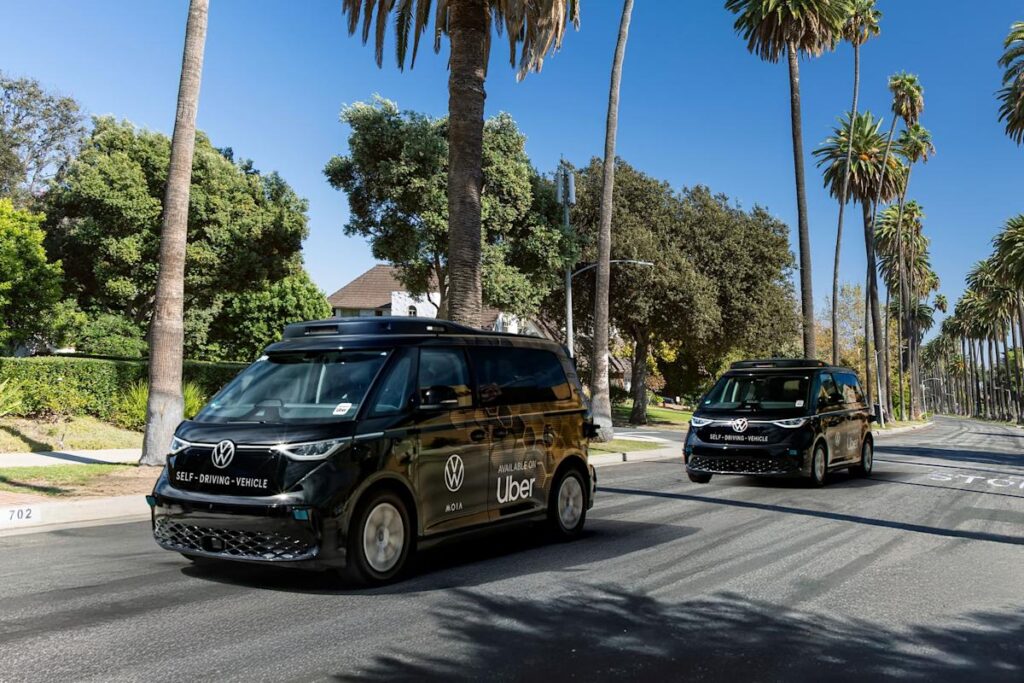
<span class=caption-credit> Volkswagen/Uber</span>
Uber Volkswagen Robotaxi Partnership: Thousands of ID. Buzz EVs Coming to US Fleet
Table of Contents
- Uber Volkswagen Robotaxi Partnership Announcement
- Deployment Timeline and Testing Phase
- ID. Buzz EV Specifications and Features
- MOIA Autonomous Driving Technology
- Market Strategy and Geographic Expansion
- Robotaxi Industry Context and Competition
- Future Implications for Ride-Hailing
- Frequently Asked Questions
The iconic Volkswagen ID. Buzz electric vehicle will form the backbone of Uber’s expanded robotaxi service through the new Uber Volkswagen robotaxi partnership. (Image Credit: Volkswagen/Uber)
The groundbreaking Uber Volkswagen robotaxi partnership is set to transform the autonomous ride-hailing landscape as the two industry giants announce plans to deploy thousands of electric ID. Buzz vehicles as self-driving taxis across multiple US markets. This ambitious Uber Volkswagen robotaxi partnership represents a significant expansion of Uber’s autonomous vehicle strategy and Volkswagen’s push into the future of transportation.
Testing for the Uber Volkswagen robotaxi partnership is scheduled to begin later this year, initially with human safety drivers at the wheel to ensure a smooth transition to full autonomy. If development proceeds according to plan, the companies aim to launch commercial Uber Volkswagen robotaxi partnership operations in Los Angeles by late 2026, marking a significant milestone in the adoption of autonomous electric vehicles for public transportation.
Uber Volkswagen Robotaxi Partnership Announcement
The Uber Volkswagen robotaxi partnership represents a convergence of expertise from two global transportation leaders. Announced as a long-term strategic collaboration, this alliance will integrate Volkswagen’s iconic ID. Buzz electric vehicles with autonomous driving technology developed by Volkswagen AG’s MOIA division. The Uber Volkswagen robotaxi partnership aims to deploy these vehicles at scale throughout the coming decade.
Under the terms of the Uber Volkswagen robotaxi partnership, the companies plan to introduce thousands of autonomous ID. Buzz vehicles across various US metropolitan markets, significantly expanding the availability of electric, self-driving transportation options for consumers while furthering both companies’ sustainability and innovation goals.
This collaboration builds upon Uber’s existing partnerships in the autonomous vehicle space, most notably with Waymo. However, the Uber Volkswagen robotaxi partnership represents Uber’s first major deal with a traditional automotive manufacturer to develop and deploy purpose-built robotaxis at scale, potentially accelerating the timeline for widespread autonomous ride-hailing adoption.
Deployment Timeline and Testing Phase
The Uber Volkswagen robotaxi partnership will follow a carefully structured deployment timeline, beginning with a comprehensive testing phase set to commence in late 2025. During this initial phase, the autonomous ID. Buzz vehicles will operate with human safety drivers monitoring the system and ready to take control if necessary, ensuring passenger safety while gathering valuable real-world operational data.
| Deployment Phase | Timeline | Details |
|---|---|---|
| Initial Testing | Late 2025 | Human safety drivers present; limited geographic area |
| Los Angeles Launch | Late 2026 | First commercial deployment with limited autonomy |
| Expansion Phase | 2027-2028 | Rollout to additional US markets |
| Full Deployment | By 2035 | Thousands of vehicles across multiple US cities |
Following successful testing, the Uber Volkswagen robotaxi partnership plans to launch commercial operations in Los Angeles by late 2026. This initial market was strategically selected due to the city’s favorable regulatory environment for autonomous vehicles, diverse driving conditions, and strong demand for innovative transportation solutions. The Uber Volkswagen robotaxi partnership aims to expand to additional US markets in subsequent years, with a target of deploying thousands of vehicles by 2035.
ID. Buzz EV Specifications and Features

The Volkswagen ID. Buzz features spacious interiors making it ideal for the Uber Volkswagen robotaxi partnership’s autonomous ride-hailing service. (Image Credit: Volkswagen)
The Volkswagen ID. Buzz serving as the foundation for the Uber Volkswagen robotaxi partnership is an electric reimagining of VW’s classic Type 2 Microbus, combining nostalgic design with cutting-edge technology. The vehicle arrived in US markets last year with a starting price of $59,995 for the base model, but the robotaxi version will feature significant modifications to accommodate autonomous operation.
Key Features of the ID. Buzz Robotaxi:
- All-electric drivetrain with approximately 260 miles of range
- Spacious interior accommodating up to four passengers
- Advanced sensor suite including LiDAR, radar, and cameras
- Dedicated compute platform for autonomous operation
- User interface displays for trip information and vehicle status
- Climate-controlled cabin with passenger amenities
- Wheelchair accessibility in select vehicles
The iconic design and spacious interior of the ID. Buzz make it particularly well-suited for robotaxi operations under the Uber Volkswagen robotaxi partnership. The vehicle’s electric powertrain aligns with both companies’ sustainability objectives while providing operational cost advantages over combustion-engine alternatives. For the Uber Volkswagen robotaxi partnership, the vehicles will be custom-configured to optimize the autonomous ride-hailing experience.
MOIA Autonomous Driving Technology
A critical component of the Uber Volkswagen robotaxi partnership is the autonomous driving technology being supplied by Volkswagen AG’s MOIA division. MOIA, established in 2016 as Volkswagen’s mobility services company, has been developing advanced self-driving systems specifically optimized for passenger transportation services.
The technology stack being deployed in the Uber Volkswagen robotaxi partnership integrates multiple sensor types, sophisticated machine learning algorithms, and high-definition mapping to enable safe autonomous operation in complex urban environments. MOIA’s approach emphasizes redundancy and failsafe mechanisms to ensure passenger safety under the Uber Volkswagen robotaxi partnership.
Volkswagen’s MOIA division has been quietly developing its autonomous driving technology for several years, with extensive testing in European markets. The Uber Volkswagen robotaxi partnership represents MOIA’s first major commercial deployment in the United States, potentially establishing Volkswagen as a significant player in the autonomous vehicle technology space alongside companies like Waymo, Cruise, and Tesla.
Under the Uber Volkswagen robotaxi partnership, MOIA will provide not only the core autonomous driving technology but also the supporting cloud infrastructure for fleet management, remote monitoring, and continuous improvement of the system through machine learning. This integrated approach aims to deliver a seamless experience for both operators and passengers.
Market Strategy and Geographic Expansion
The Uber Volkswagen robotaxi partnership outlines an ambitious market strategy beginning with Los Angeles in 2026 and expanding to additional US metropolitan areas in subsequent years. The companies have indicated that the selection of future markets will be based on a combination of regulatory environment, consumer demand, traffic patterns, and weather conditions suitable for autonomous operation.
Strategic Considerations for Market Expansion:
- Regulatory framework supportive of autonomous vehicle testing and deployment
- Existing Uber ridership and demand patterns
- Traffic conditions and road infrastructure compatibility
- Weather patterns conducive to autonomous sensor operation
- Charging infrastructure availability for electric vehicle fleet
- Consumer acceptance and adoption of autonomous transportation
For the Uber Volkswagen robotaxi partnership, integration with Uber’s existing platform will provide immediate access to a large customer base and sophisticated demand prediction capabilities. The service will likely be offered as a premium option within the Uber app, similar to the company’s current approach with Waymo robotaxis in markets like San Francisco, Phoenix, Los Angeles, and Austin.
The Uber Volkswagen robotaxi partnership represents a significant commitment from both companies, with the potential to reshape urban transportation in the targeted markets. By leveraging Uber’s platform and Volkswagen’s manufacturing capabilities, the partnership aims to achieve the scale necessary for commercial viability in the autonomous ride-hailing sector.
Robotaxi Industry Context and Competition
The Uber Volkswagen robotaxi partnership enters a competitive landscape where several companies are racing to commercialize autonomous ride-hailing services. Waymo, backed by Alphabet, currently leads the field with operational robotaxi services in multiple US cities, including an existing partnership with Uber that allows customers to book Waymo vehicles through the Uber app.
| Company | Vehicle Type | Operating Markets | Technology Approach |
|---|---|---|---|
| Waymo (Alphabet) | Modified Jaguar I-PACE EVs | Phoenix, San Francisco, Los Angeles, Austin | Custom LiDAR and comprehensive sensor suite |
| Cruise (GM) | Modified Chevrolet Bolt EVs | San Francisco (limited) | Multi-modal sensing with extensive simulation |
| Zoox (Amazon) | Purpose-built bidirectional EV | Testing phase | 4D radar and symmetrical vehicle design |
| Uber-Volkswagen | ID. Buzz EVs | Testing beginning 2025; LA launch 2026 | MOIA autonomous system with integrated mapping |
What distinguishes the Uber Volkswagen robotaxi partnership from some competitors is the use of a production vehicle with cultural appeal rather than a utilitarian design. The ID. Buzz’s distinctive styling and heritage connection may provide a marketing advantage as the Uber Volkswagen robotaxi partnership works to build consumer trust and excitement around autonomous transportation.
The Uber Volkswagen robotaxi partnership also represents a strategic pivot for Uber, which has pursued multiple approaches to autonomous vehicle technology over the years. After selling its internal self-driving unit to Aurora in 2020, Uber has focused on partnering with technology providers rather than developing its own autonomous systems. The Uber Volkswagen robotaxi partnership extends this strategy while giving the company more direct influence over vehicle design and deployment.
Future Implications for Ride-Hailing
The Uber Volkswagen robotaxi partnership signals a significant evolution in the ride-hailing industry, potentially accelerating the transition toward autonomous, electric fleets. If successful, this model could transform the economics of ride-hailing by removing driver costs while simultaneously reducing environmental impact through electrification.
Beyond the immediate business implications, the Uber Volkswagen robotaxi partnership may contribute to broader transportation shifts, including reduced private car ownership in urban areas, decreased parking demand, and new approaches to urban planning that accommodate autonomous vehicle pickup and dropoff zones.
For Volkswagen, the Uber Volkswagen robotaxi partnership represents a strategic entry into mobility services beyond vehicle manufacturing, potentially opening new revenue streams and business models. For Uber, the partnership advances the company’s vision of becoming a comprehensive mobility platform rather than solely a ride-hailing service with human drivers.
As the Uber Volkswagen robotaxi partnership develops, it may also influence regulatory frameworks for autonomous vehicles, potentially accelerating the establishment of consistent standards for testing, certification, and operation of self-driving vehicles in commercial transportation services.
Frequently Asked Questions
When will the Uber-Volkswagen robotaxis be available to the public?
According to the announced timeline, the Uber Volkswagen robotaxi partnership plans to begin commercial operations in Los Angeles by late 2026, following a testing phase that will start in late 2025 with human safety drivers.
What vehicle will be used in the Uber-Volkswagen robotaxi fleet?
The Uber Volkswagen robotaxi partnership will utilize the Volkswagen ID. Buzz, an all-electric modern version of VW’s classic Type 2 Microbus, specially equipped with autonomous driving technology developed by Volkswagen’s MOIA division.
How many autonomous Volkswagen vehicles will Uber deploy?
The Uber Volkswagen robotaxi partnership plans to deploy thousands of autonomous ID. Buzz vehicles across multiple US markets over the next decade, with the exact number likely depending on performance, demand, and regulatory developments.
Will human drivers be completely eliminated in these vehicles?
Initially, the vehicles will operate with human safety drivers during the testing phase beginning in 2025. The Uber Volkswagen robotaxi partnership aims to transition to fully autonomous operation for commercial service, though regulatory requirements may vary by market.
How does this partnership compare to Uber’s work with Waymo?
While Uber already offers rides in Waymo autonomous vehicles in several cities, the Uber Volkswagen robotaxi partnership represents Uber’s first major collaboration with a traditional automaker to develop and deploy purpose-built robotaxis at scale, potentially offering greater customization and integration opportunities.
The Uber Volkswagen robotaxi partnership marks a significant milestone in the evolution of autonomous transportation, bringing together Uber’s ride-hailing expertise with Volkswagen’s automotive engineering and MOIA’s autonomous technology. By deploying thousands of electric ID. Buzz vehicles as self-driving taxis across US markets over the coming decade, the Uber Volkswagen robotaxi partnership aims to make autonomous, sustainable mobility a daily reality for urban consumers. Beginning with testing in 2025 and a planned commercial launch in Los Angeles by late 2026, this collaboration demonstrates both companies’ commitment to shaping the future of transportation through innovation, sustainability, and strategic partnership. As the autonomous vehicle industry continues to mature, the Uber Volkswagen robotaxi partnership positions both companies to play leading roles in the transformation of urban mobility.





